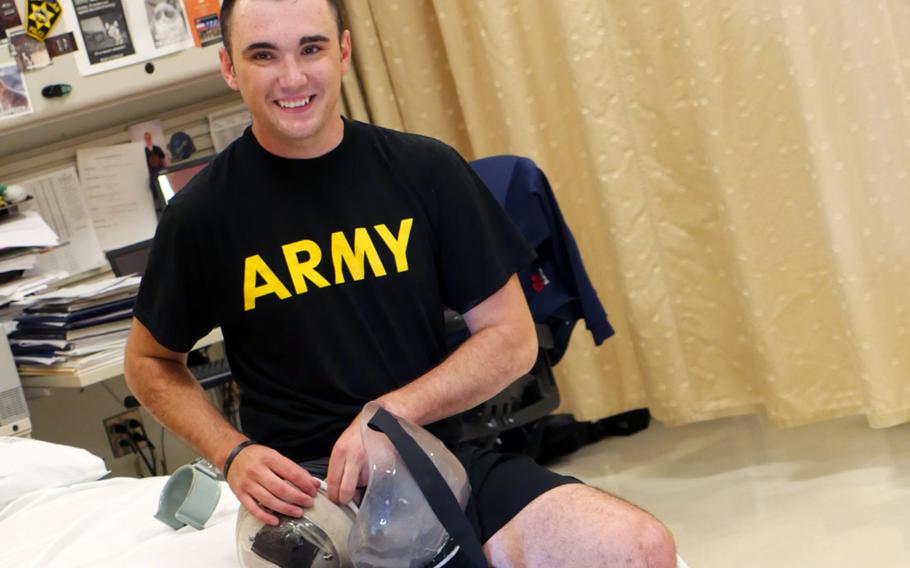
Spc. Ezra Maes adjusts his prosthetic leg prior to physical rehabilitation at the Center for the Intrepid, Brooke Army Medical Center's cutting-edge rehabilitation center on Joint Base San Antonio-Fort Sam Houston, Oct. 2, 2019. (Corey Toye/U.S. Army)
When a tank crash in Slovakia trapped Spc. Ezra Maes’ leg in a turret gear, he pulled himself free to help save his badly wounded crew mates, severing his leg in the process.
“If I didn’t help myself, my crew, no one was going to,” Maes was quoted as saying in an Army statement earlier this month. “I knew I had to do everything I could to survive.”
The M1A2 Abrams tank crew had deployed to Poland with the 1st Cavalry Division’s 1st Armored Brigade Combat Team as part of the U.S. mission to deter Russian aggression and bolster allies in the region.
On the second day of a weeklong exercise in southern Slovakia in September 2018, three crewmembers who had gone to sleep in their tank were jolted awake as the nearly 70-ton machine started rolling down a slope, gaining speed as it went.
Maes, then 20, was the loader on the tank’s 120mm main cannon. He called out to the driver to stop, but the parking brake had failed and a hydraulic leak had left operational systems unresponsive, making emergency braking useless, the Army statement said.
“We realized there was nothing else we could do and just held on,” Maes said.
The tank crashed into an embankment at the bottom of a ravine, tossing its crew around. The tank’s gunner, Sgt. Aechere Crump, was bleeding heavily from a cut on her thigh, and driver Pfc. Victor Alamo was pinned in the driver’s compartment with a broken back, the Army said.
Maes’ leg got caught in a turret gear and was smashed. He thought the leg was simply broken and tried to free himself to get a tourniquet from the rear of the tank to help Crump.
“I pushed and pulled at my leg as hard as I could to get loose and felt a sharp tear,” he said. “When I moved away, my leg was completely gone.”
Bleeding profusely, he was determined to get to the medical kit, but soon felt lightheaded. Realizing he was going into shock, he focused on staying calm, keeping his heart rate down and elevating his lower body, then fashioned his belt into a makeshift tourniquet.
He called to Crump, who had done the same with her own belt, telling her to radio for help.
But the radio wasn’t working. No one knew they were down in the ravine, Maes feared, and they might die without immediate help.
Then, somewhere in the cabin, Maes’ phone buzzed. It was the only one that wasn’t broken and had working cell service.
Crump, who also had a broken arm, crawled to find the device and threw it to him. While his teeth clenched the makeshift tourniquet on his leg, he unlocked it and sent a text for help. Soon rescuers arrived and loaded them in Humvees.
The last thing Maes recalls at the crash site was seeing his sergeant major running up the hill carrying the leg on his shoulder, he said. Maes wanted to see if it could be reattached, but it was smashed too badly.
The young soldier, who’d joined the Army to follow in his grandfather’s footsteps, had also broken his pelvis in five spots, his ankle and his shoulder. He and the others were treated in Slovakia before being evacuated to the Army’s hospital in Landstuhl, Germany, then on to Brooke Army Medical Center in San Antonio. The other two were also evacuated to Texas to recover from their injuries.
Maes spent four months in intensive care undergoing near daily surgeries and battling an infection, the Army said. He’s now assigned to BAMC’s Warrior Transition Battalion and undergoing physical and occupational therapy at the hospital’s outpatient rehabilitation facility, known as the Center for the Intrepid.
“I feel super lucky,” he said. “My crew all does. So many things could have gone wrong. Besides my leg, we all walked away pretty much unscathed.”
At the time of the crash, he’d begun the process of applying to the U.S. Military Academy at West Point, said a GoFundMe campaign set up to pay for travel and other expenses for family to be with him during his recovery. He’s an avid athlete who loved snowboarding, rock climbing and golf, it said.
Now he’s preparing to receive a prosthetic leg through a procedure that will implant a titanium rod in his bone. And he plans to be a prosthetist to help others regain their mobility, the Army statement said.
“When something like this happens, it’s easy to give up because your life won’t be the same, and you’re not wrong,” he said. “Life will take a 180, but it doesn’t have to be a bad thing. Don’t let it hinder you from moving forward.”
garland.chad@stripes.com Twitter: @chadgarland